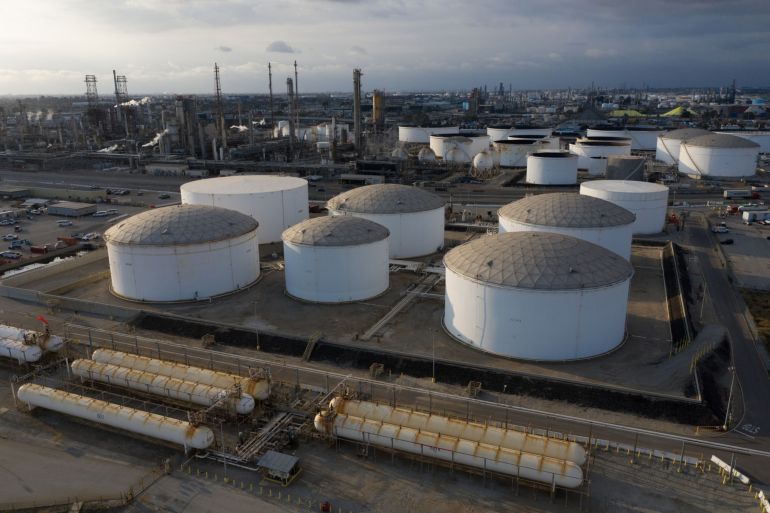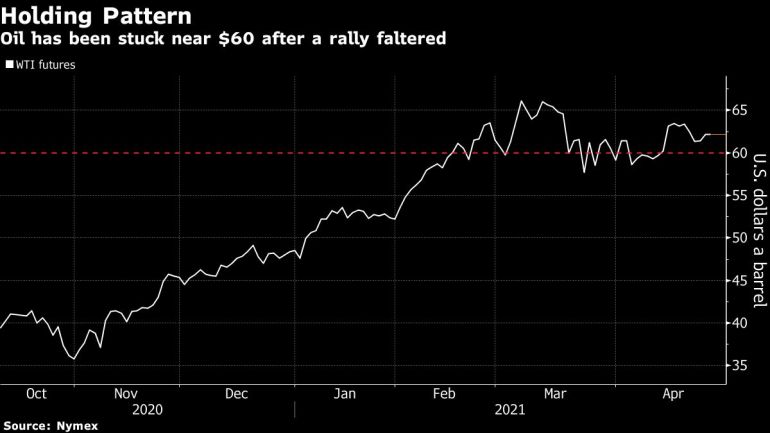Oil slips below $62 as India virus cases rise
Fifth day of record number of COVID infections in the world’s third-biggest oil importer is expected to hit demand.

Oil prices have fallen more than 1 percent on fears that surging COVID-19 cases in India will dent fuel demand in the world’s third-biggest oil importer and as investors prepared for a planned increase in crude output from the world’s top producers in May.
Brent crude fell 72 cents, or 1.1 percent, to $65.39 a barrel by 06:53 GMT on Monday, following a 1.1-percent rise on Friday. US West Texas Intermediate (WTI) crude futures were down 67 cents, or 1.1 percent, at $61.47 a barrel, after rising 1.2 percent on Friday.
Keep reading
list of 4 itemsIndia’s COVID crisis ‘beyond heartbreaking’: WHO
‘Tough times’: Cricketers pull out of India’s IPL over COVID
Photos: COVID patients beg for oxygen outside India’s hospitals
Both benchmark crudes fell about 1 percent last week.
“Market sentiment was dented on worries that surging number of COVID-19 cases in some countries, especially in India, will slash fuel demand,” Kazuhiko Saito, chief analyst at commodities broker Fujitomi Co.
India’s new coronavirus infections hit a record peak for a fifth day on Monday as countries including the United Kingdom, Germany and the United States pledged to send urgent medical aid to help battle the crisis overwhelming its hospitals.
An estimate from consultancy FGE is for gasoline demand in India to slip by 100,000 barrels per day (bpd) in April and by more than 170,000 bpd in May. India’s total gasoline sales came to nearly 747,000 bpd in March.
Diesel demand, which at about 1.75 million bpd accounts for about 40 percent of refined fuel sales in India, may slump by 220,000 bpd in April and by another 400,000 bpd in May, FGE says.
Signs of strain on India’s refiners are starting to emerge. Mangalore Refinery & Petrochemicals Ltd has cut processing rates, while Indian Oil Corp has so far failed to issue an expected tender to purchase West African crude.
A shift from oil to grain
In Japan, the world’s fourth-largest oil buyer, a third state of emergency in Tokyo, Osaka and two other prefectures began on Sunday, affecting nearly a quarter of the population as the country attempts to combat a surge in cases.

“Investors, including speculators, have been shifting funds from oil markets to grain markets recently as volatility has been much higher in prices of corn and other grains,” Fujitomi’s Saito said.
Chicago corn, wheat and soybeans hit multi-year highs last week amid concerns over cold weather damage to crops across the US grain belt, along with expectations for more use of agricultural products for biofuels.
Oil’s robust start to the year faltered in mid-March as some regions started to see a virus resurgence, although prices are still up almost 30 percent in 2021.
The Organization of the Petroleum Exporting Countries and allies led by Russia, known as OPEC+, surprised the market at its April 1 meeting by agreeing to ease production curbs by 350,000 barrels per day (bpd) in May, another 350,000 bpd in June and a further 400,000 bpd or so in July.
“There were technical adjustments as the oil markets’ rally has been overdone and as the OPEC+ is set to add supply from May,” said Naohiro Niimura, a partner at Market Risk Advisory, adding Brent could head down to approximately $60 a barrel.
The producer group will hold a largely technical meeting this week, with major changes to policy unlikely, Russian Deputy Prime Minister and OPEC+ sources said last week. A technical committee meeting is set for Monday.